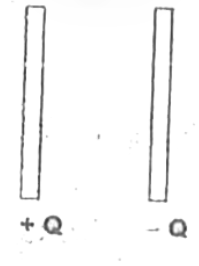The charge on a parallel plate capacitor varies as q=q0cos2πt. The plates are very large and close together (area = A, separation = d). The displacement current through the capacitor is
q02πυsinπυt
−q02πυsin2πυt
q02πsinπυt
q0πυsin2πυt
The correct Answer is:B
To find the displacement current through a parallel plate capacitor where the charge varies as q=q0cos(2πt), we will follow these steps:
Step 1: Understand the concept of displacement current
Displacement current Id is defined as the rate of change of electric flux through a surface. The formula for displacement current is given by:
Id=ϵ0dΦdt
where ϵ0 is the permittivity of free space and Φ is the electric flux.
Step 2: Calculate the electric field
For a parallel plate capacitor, the electric field E between the plates is given by:
E=QAϵ0
where Q is the charge on the plates and A is the area of the plates.
Step 3: Calculate the electric flux
The electric flux Φ through the capacitor is given by:
Φ=A⋅E=A⋅QAϵ0=Qϵ0
Step 4: Substitute the expression for charge
Given that Q=q0cos(2πt), we can substitute this into the expression for electric flux:
Φ=q0cos(2πt)ϵ0
Step 5: Differentiate the electric flux
Now, we need to find the rate of change of electric flux with respect to time:
dΦdt=ddt(q0cos(2πt)ϵ0)=q0ϵ0ddt(cos(2πt))
Using the derivative of cosine, we have:
ddt(cos(2πt))=−2πsin(2πt)
Thus,
dΦdt=q0ϵ0(−2πsin(2πt))=−2πq0sin(2πt)ϵ0
Step 6: Substitute back to find displacement current
Now, substituting this back into the formula for displacement current:
Id=ϵ0dΦdt=ϵ0(−2πq0sin(2πt)ϵ0)
The ϵ0 cancels out:
Id=−2πq0sin(2πt)
Final Answer
The displacement current through the capacitor is:
Id=−2πq0sin(2πt)
Displacement current Id is defined as the rate of change of electric flux through a surface. The formula for displacement current is given by:
Id=ϵ0dΦdt
where ϵ0 is the permittivity of free space and Φ is the electric flux.
For a parallel plate capacitor, the electric field E between the plates is given by:
E=QAϵ0
where Q is the charge on the plates and A is the area of the plates.
The electric flux Φ through the capacitor is given by:
Φ=A⋅E=A⋅QAϵ0=Qϵ0
Given that Q=q0cos(2πt), we can substitute this into the expression for electric flux:
Φ=q0cos(2πt)ϵ0
Now, we need to find the rate of change of electric flux with respect to time:
dΦdt=ddt(q0cos(2πt)ϵ0)=q0ϵ0ddt(cos(2πt))
Using the derivative of cosine, we have:
ddt(cos(2πt))=−2πsin(2πt)
Thus,
dΦdt=q0ϵ0(−2πsin(2πt))=−2πq0sin(2πt)ϵ0
Now, substituting this back into the formula for displacement current:
Id=ϵ0dΦdt=ϵ0(−2πq0sin(2πt)ϵ0)
The ϵ0 cancels out:
Id=−2πq0sin(2πt)
The displacement current through the capacitor is:
Id=−2πq0sin(2πt)
Topper's Solved these Questions
- ELECTROMAGNETIC WAVESBOOK - NCERT FINGERTPS ENGLISHCHAPTER - ELECTROMAGNETIC WAVESEXERCISE - HOTS
8 Videos
- ELECTROMAGNETIC WAVESBOOK - NCERT FINGERTPS ENGLISHCHAPTER - ELECTROMAGNETIC WAVESEXERCISE - NCERT EXEMPLAR PROBLEMS
7 Videos
- ELECTROMAGNETIC INDUCTIONBOOK - NCERT FINGERTPS ENGLISHCHAPTER - ELECTROMAGNETIC INDUCTIONEXERCISE - NCERT Exemplar
6 Videos
- ELECTROSTATIC POTENTIAL AND CAPACITANCE BOOK - NCERT FINGERTPS ENGLISHCHAPTER - ELECTROSTATIC POTENTIAL AND CAPACITANCE EXERCISE - Assertion And Reason
15 Videos
Similar Questions
The charge on a parallel plate capacitor varies as q=q0cos2πft. The plates are very large and close together (area=a,separation=d). Neglecting the edge effects, find the displacement current through the capacitor.
View SolutionThe charge on a parallel plate capacitor varies as =q0cos2πft. The plates are very large and close together (area=a,separation=d). Neglecting the edge effects, find the displacement current through the capacitor.
View SolutionConsider a parallel plate capacitor having charge Q. Then,

View SolutionIf the plates of a parallel plate capacitor are not equal in area, then
View SolutionEach plate of a parallel plate capacitor has a charge q on it. The capacitor is now connected to a battery. Now,
View SolutionA parallel plate capacitor has capacitance of 1.0F. If the plates are 1.0mm apart, what is the area of the plates?
View SolutionA parallel plate capacitor is charged. If the plates are pulled apart
View SolutionA parallel plate capacitor is charged and then isolated. On increasing the plate separation
View SolutionThe plates of a parallel plate capacitor are not exactly parallel. The surface charge density is therefore,
View SolutionIn figure , the plates of a parallel plate capacitors have unequal charges. Its capacitance is C. P is a point outside the capacitor and close to the plate of charge -Q. The distance between the plates is d. Then

View Solution
